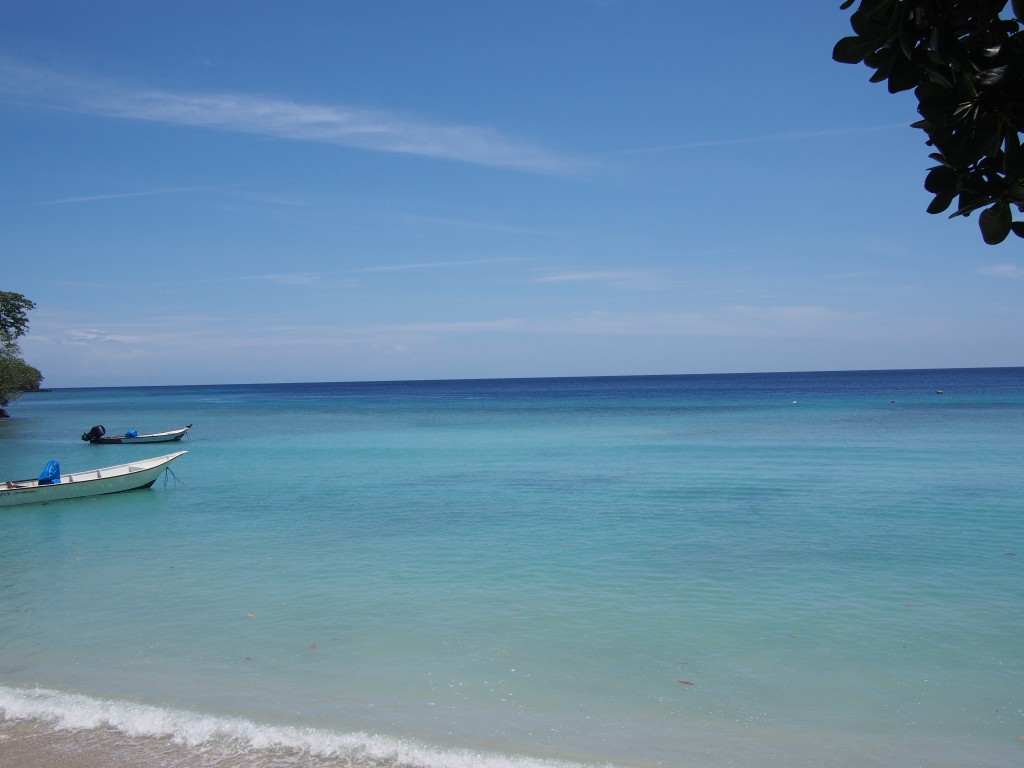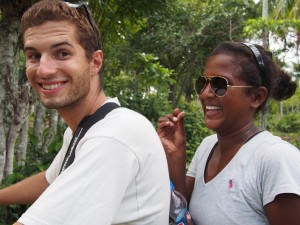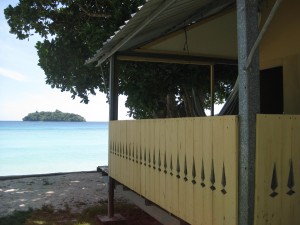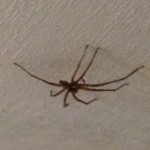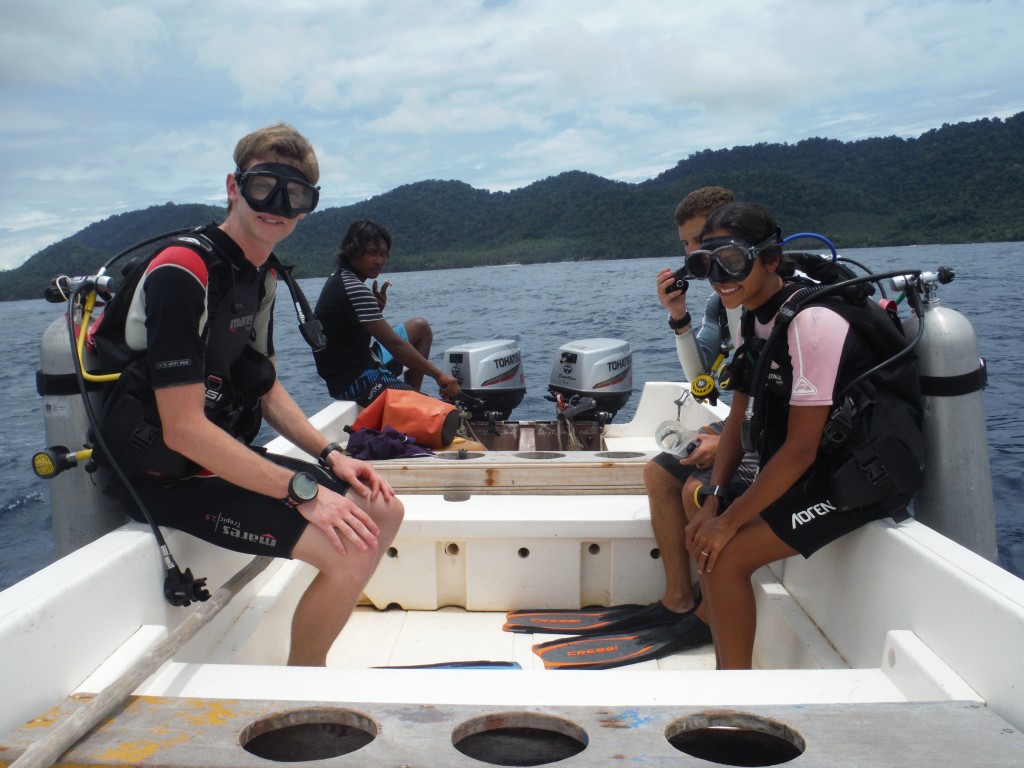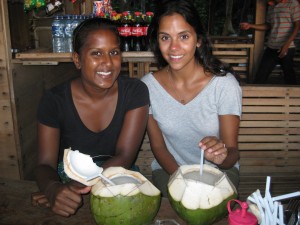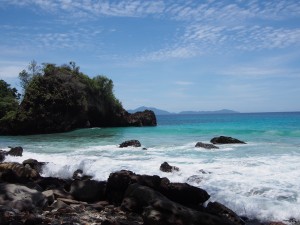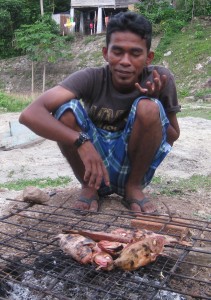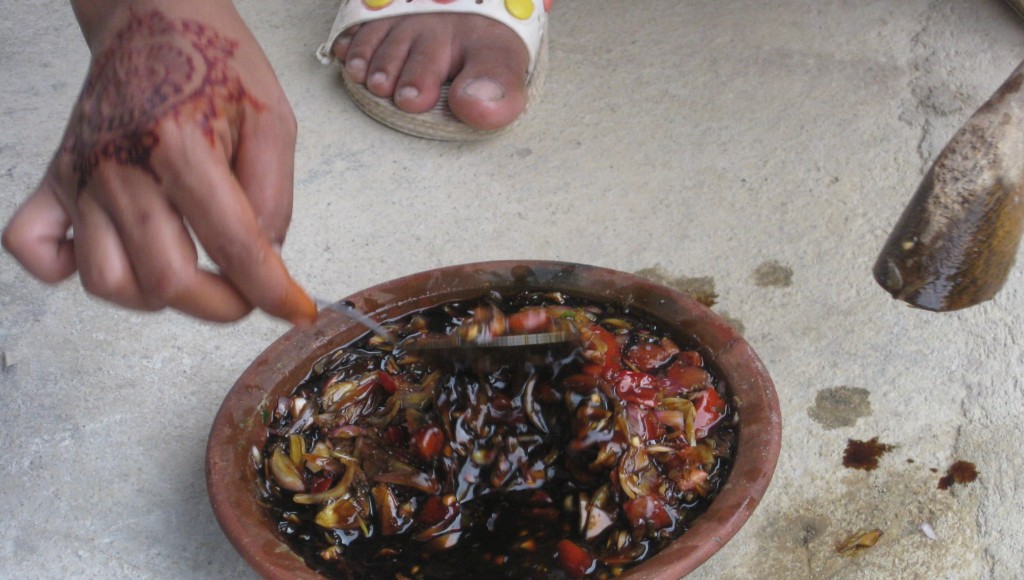We always intended to go to Indonesia on this trip. It’s a fantasy location– more than 13,000 balmy islands offering everything: jungles, cities, resort destinations, tiny barely inhabited islands that take days to get to, and so on. Like most travelers, we had heard great and awful things about Bali (all of which turned out to be true). Until we started diving on Tioman Island in Malaysia, we’d never heard of our first Indonesian destination. Sam and Anita were divemasters in training on Tioman with plans to head to Pulau Weh after completing their certification, before heading back to school in Switerland. Sam had spent quite a bit of time there previously, and really sold us on the diving and the overall feel of the place. He may, in fact, be a plant for the nascent Pulah Weh tourism bureau. Either way, he mentioned an underwater volcano, amazing corals, great visibility, and a delicious Italian restaurant (guess which of us was sold on the latter). Indonesia was vaguely next on our list after Malaysia, so we made tentative plans to make Pulau Weh our first stop (before, say, figuring out where it was or how to get there) and to meet up with Sam and Anita there.
Three weeks later, my foot was healed, we’d eaten everything in sight in Penang and enjoyed Borneo (especially the wild orangutans!), and we were ready to get back to diving. We flew to Banda Aceh in northern Sumatra and caught the next ferry to the island. We then haggled our way into a becak taxi (actually an enlarged motorcycle sidecar) and careened across the island. We met up with our friends at Scuba Weh, the dive shop they worked with in Iboih Beach.
Much of the accommodation on Iboih was booked when we arrived. Luckily, Sam and Anita stayed outside of town and had arranged for an open bungalow at their place just in case. We followed Sam and Anita on a ten-minute drive to a beautiful, quiet beach, with our bungalow perfectly located next to the ocean. As for the bungalow itself… it was definitely rustic. It was not exactly clean inside, and various parts were open the outdoors. But it had a mosquito net, a bathroom (albeit with a bucket flush toilet–common in Indonesia– and no sink–less common), and a hammock on the porch. Also it cost less than $6.50 per night, the proprietors were really friendly, and they made a mean fruit salad. We decided to stay there for a day or two, at which point I was totally attached to it the occasional scary bug notwithstanding. By the end, even Brian (who, while a cowboy, is not exactly a camper: “It’s just silly when you have the option of a perfectly good bed”) was a fan.
During the following 12 days we explored the island by motorbike, did a lot of diving for a crazy cheap price with a friendly if occasionally dysfunctional diveshop, ate countless curries, banana pancakes, and grilled fish with sambal (also, yes, quite a bit of Italian food), attended a wedding, hiked to a waterfall, were nearly maimed by monkeys, visited “kilometer zero,” played a lot of euchre and a Swiss game we renamed “Snapper,” and generally had a great time.
Diving. Diving in Pulau Weh may be the island’s biggest tourist draw. It certainly was the selling point for us. The water is clear and warm enough to dive in a short wetsuit, the corals are incredibly varied and colorful, and the sea life is almost too much to take in: lots of moray eels, octopus, nudibranch, lionfish, scorpionfish, rays, and so on. We did more than a dozen dives while there, enough to convince us that diving should be a significant part of the rest of this trip.
Credit is due not only to the island’s natural beauty, but also to Sam and Anita. They worked out a deal with Scuba Weh to dive free and guide customers when needed, and we filled the role of the customers. We were comfortable working on our skills in somewhat more challenging circumstances (e.g. currents, a night dive, a wreck dive) in part because we had basically one on one attention, and also because it was a lot of fun.
Exploring the island. Pulah Weh is beautiful and largely undeveloped. Parts of the island were destroyed in the December 2004 tsunami, which triggered something of a building boom with UN funds, but significant portions of the island’s coastal property are pristine. There are hidden beaches, a popular waterfall, and little-known hot spring wells complete with a bucket for makeshift bathing– our first hot shower in more than a week was very welcome. There are old Japanese bunkers that now serve as a tourist attraction and (for us) a picnic spot. Roads around the island weave through the jungle and offer incredible ocean views.
A frequently used road “features” Monkey Hill, where at least 20 monkeys hang out all over the place (including the middle of the road). This sounds charming, and tourists in vans often slow or stop to take pictures and throw food to them. The monkeys are therefore conditioned to expect food when vehicles slow down on the hill. When you’re on a scooter, and monkeys are all over the road, slowing down can be necessary, but I was almost mauled when a huge, hissing guy launched himself at my leg and chased us down the road. Visions of rabies shots dancing in my head, I took to tucking my legs up on the scooter seat and urging B to drive faster around that part of the road. No photos of the monkeys, for obvious life preservation reasons.
Local life. While Pulau Weh is a tourist destination, it’s relatively rare to encounter them outside of a few beaches. When we were wandering around the rest of the island, we (particularly Brian and Sam) were a definite attention draw for the locals. We’d hear the word “bule” over and over again, mentioned between adults or shouted by children. It means foreigner, or tourist, and (much like the term gringo in parts of South America) it’s not at all unfriendly. Brian and Sam were asked several times to pose in strangers’ photos. Anita and I were asked if we spoke Indonesian. Pretty standard.
Less standard, at least for us, was the island’s conservatism. The population is largely Muslim, and even in the tourist areas, women are strongly encouraged to cover up. Even when drying off at the dive shop, it’s not really a place for women to walk around in a bathing suit, a pair of shorts, or a tank top (men can be shirtless all day long). Similarly, showing affection in public (as in holding hands or hugging) is strongly discouraged. And with one or two discreet exceptions, alcohol isn’t for sale anywhere. All of these minor adjustments resulted in a sort of health cleanse for me– we drank even more fresh juice and tea than usual, and I stayed pretty covered up from the sun!
Because Sam previously spent time on Pulau Weh, we got to experience more of the local life than we otherwise would have. In fact, on our first full day on the island, we were invited to tag along to the wedding of his friend Safwan’s sister-in-law. A chance to attend a Muslim wedding on a tiny Indonesian island is not likely to come along twice, so after making sure it would actually be fine if we came (much like traditional Indian weddings, it seems to be a more-the-merrier kind of thing) and that our limited attire options were fine (basically, as long as the women are covered up, it doesn’t matter), we went for it.
Safwan and his wife Yuni met us outside of the tiny village where the bride lived, and took us to where her family was busy getting everything ready for the groom and his large familial entourage. Everyone was very welcoming (again, as in India, they immediately started trying to feed us even though it was 10 a.m.) and the four bules were a source of amusement for the other guests as we all waited for the groom to arrive. We spent a while hanging out with a group of women in their 20s. They had a number of questions for Anita and me, mostly about weight loss and birth control. Typical Muslim wedding conversation? Who knows. We stayed out of the way during the ceremony but were full participants in the lunch afterward. There were at least a hundred guests there, and enough food to feed twice as many. I can’t endorse the fermented rice balls soaked in palm wine, but everything else was delicious.
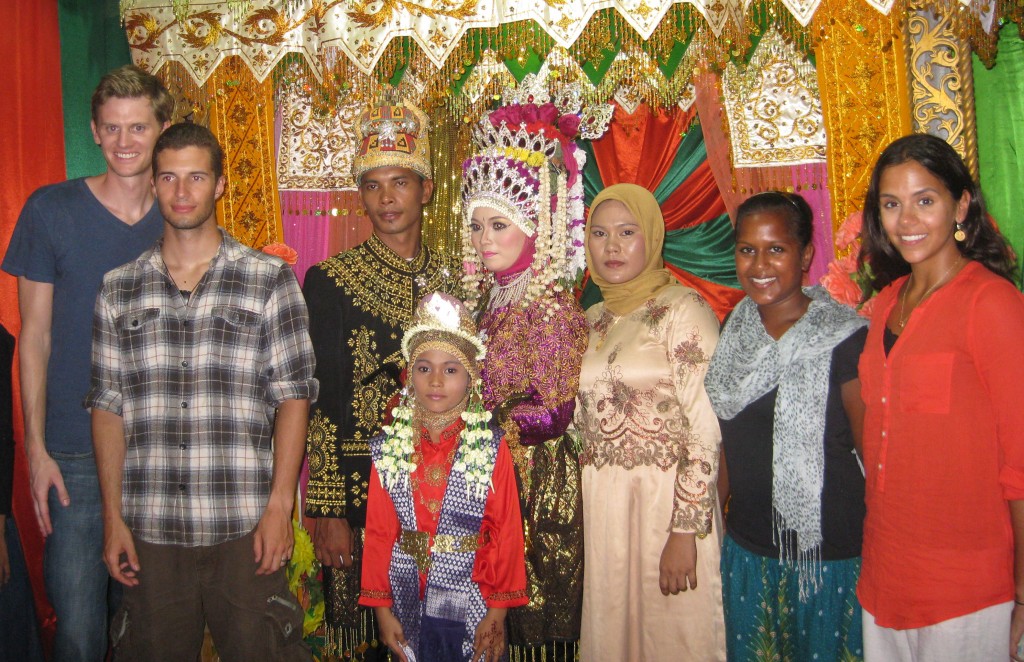
Sweaty wedding guests. Yuni is between the bride and Anita. I have no idea how the ornately dressed little girl fits in, but she was cute.
It was a hot day, and the poor bride and groom spent the whole afternoon in a tiny room posing for photos with their guests (including, at someone’s insistence, the four of us). They were troopers, but the masses of kids running all over the place were much more excited about having their photos taken.
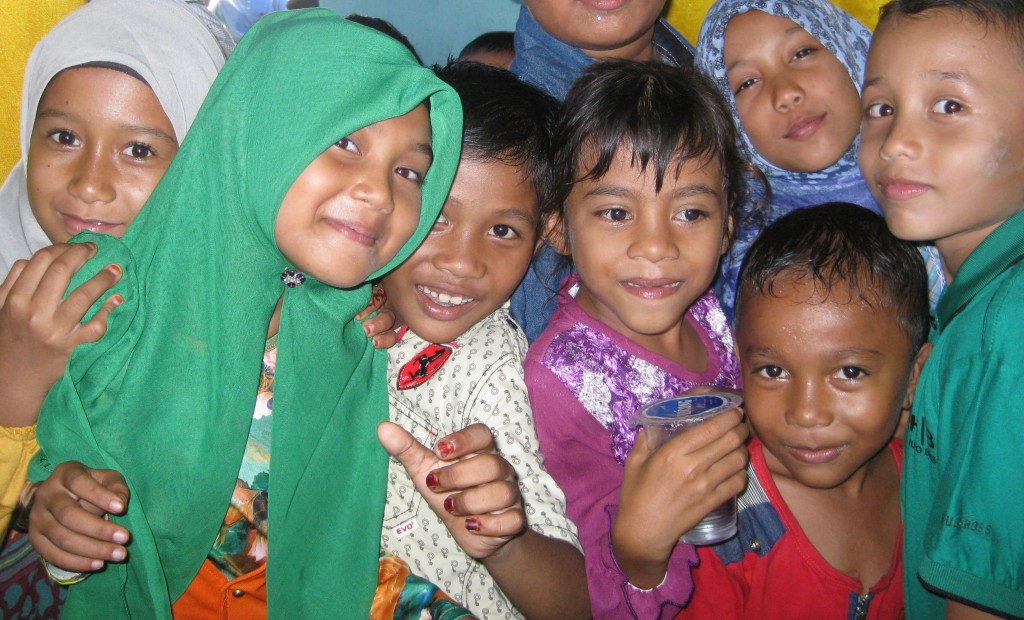
Super cute kids wanted to see every picture after it was taken. Invariably they collapsed into giggles before demanding another one.
We joined Safwan and Yuni for fish barbecues twice– once on Pulah Weh and the second time on nearby Kla island, which we reached via Safwan’s father’s fishing boat. We picked up fresh fish from a guy with a cooler near the port, and rice and curry from roadside stands. Both times the fish was a secondary player compared to the sambal, or chili sauce, that Yuni made. It was very simple– tiny onions, peppers, a few kinds of soy sauce– but amazing. I want to bottle it and put it on pretty much everything I ever eat.

